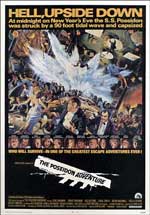 As more and more presenters begin to think of their iPad as an essential tool, it becomes equally essential to find ways to use it without dropping and destroying it mid-presentation. Grabbit seems like it could go a long way towards curing a bad case of the on-stage whoopsies. (HT to Conference Basics)
As more and more presenters begin to think of their iPad as an essential tool, it becomes equally essential to find ways to use it without dropping and destroying it mid-presentation. Grabbit seems like it could go a long way towards curing a bad case of the on-stage whoopsies. (HT to Conference Basics)
|
|
|
|
Phil Presents — Presentation Pitfalls #7: Slide synch (or lack of)
Webinar Crusher — What If I Screw Up A Live Webinar And How Do I Recover?
No Sweat Presentations! — When You Speak, Don’t Jingle or Deliver Other Distractions!
I hardly ever get a chance to quote Hitchhiker’s Guide, so whenever and opportunity presents itself, I take it (no matter how tangential it may seem):
“Oh no, not again.” It’s bad enough crash and burn once, it’s even worse if you let the same exact thing happen all over again. Let’s face it, the problems you’ve already had should be the easiest to avoid. You know, “fool me once…” and all that. You never, ever want the presenter to be standing at the lectern thinking, “Oh no, not again.” One of the best ways I’ve found to avoid this situation is to be rigorous about holding a postmortem after each and every presentation (if you prefer a less pejorative term, call it a “debrief”). Autopsy the experience. Carefully pull it apart. Cut deep and really find out what went wrong. Some random thoughts and suggestions:
It’s not like I was out there searching or anything but I found a quote that could be the official motto for Breaking Murphy’s Law:
I agree that personal failures are very good at teaching important lessons in a way that makes them difficult to forget. The only problem is there’s usually only one person in the classroom. Learn from your mistakes, but also be generous and share them so others can learn from what you went through. I know, I know, easier said than done. Just try to remember you could be saving someone else from geting their knuckles rapped.  ©iStockphoto.com/kreicher
At a previous job, we had a roll of toilet paper, affectionately known as “Buttwipe,” that was thrown into the box with the rest of the art department’s supplies and shipped to every meeting we worked. The consequences of not performing this act of raw superstition, though unspecified, were too too horrible to consider. Over the years, Buttwipe (now there’s a word I never thought I would find myself typing) suffered from severe travel fatigue and required a series of shipping tape grafts in order to continue keeping it all together while performing his crucial on-site duties. As that particular art department is no longer in existence, Buttwipe is now quietly retired and living in a closet, preferring to stay close at home after a being on the road for much of his long, globe-trotting career. Although they are basically irrational, superstitions can actually serve useful purposes. They can foster a sense of normalcy in chaotic, uncertain situations and can provide the illusion that there is some small modicum of control in an otherwise uncontrollable environment. They can also build team cohesion and esprit de corps. I have in mind something like Gene Kranz’s white vest in Apollo 13.
What superstitions do you or your colleagues invoke in order to ensure disaster doesn’t strike your meeting or presentation? Does it involve wearing a specific article of clothing? Do you need to have a particular type of coffee or eat a certain breakfast the morning of the meeting? Is it something a little more bizarre? Please share it with us in a comment.  ©iStockphoto.com/doulos Seriously, I’m not just trying to cash in on VP debate buzz. This would be a terrific article no matter what the specific context. In it, Nick Morgan makes a point that should be one of the Ten Commandments of Doing Everything Possible to Avoid Screwing Up a Presentation:
If you’re a presenter, or if you’re responsible in any way for the success of a major presentation, you need to do everything you can to make sure that this policy is put into effect. And the more important the presentation, the more exacting you need to be in the replication of the actual presenting environment. Things like podium/screen placement, confidence monitor size/positioning and they type of remote control used for advancing slide are all good examples of things a speaker needs to feel familiar and comfortable with. It will also be helpful, if you’ll be providing AV support during a presentation, to have a chance to set up and put the actual system that will be used through it’s paces. Believe me, as someone who has been there, the best time to find out you need a longer VGA cable or that the projectors time-out function hasn’t been disabled is in rehearsal, not just before the speaker is about to go on. Remember: If you rehearse like it’s the real thing, the real thing will seem like a rehearsal. [A slightly different version of this article originally appeared in the June 2008 edition of the PresentationXpert email newsletter.]
What is it about these movies that makes them perennially popular? It’s obvious that people find them entertaining. Let’s face it, there’s something very compelling about watching a disaster unfold (as long as it isn’t unfolding on or around you). These movies also offer lessons or morals that gratify our desire for karmic retribution (“Well that’s what they get for saying the boat would never sink”). And in most cases, no matter how bad things get, in the end there is some sense of triumph over great adversity or some discovery of a previously unsuspected personal strength that lets everyone leave the theater on a typically Hollywood high note. What does this have to do with giving or supporting presentations? I’m willing to bet that every person you know who has been in the business for more than a year or so has their own collection of presentation disaster stories. And these stories share many of the same characteristics that make disaster movies so popular. If you get two or more of us together you can be sure that stories are going to be told. Many of my favorite memories of being on site working a big event are from the time spend absorbing stories told by old pros who have been around a long time and been through almost everything. – – – – – Although these stories share many of the characteristics that make disaster movies entertaining, they also differ from the movies in some important ways that make them even more useful: Continue reading Think of it as an adventure, as in “The Poseidon Adventure”
PowerPoint has taken so much abuse the last couple years, isn’t it kind of refreshing when someone has something positive to say about it? I’d like to stress a couple points made in Lisa’s story. First, if you’re going to present, get there early. Lisa put herself in a position to effectively deal with any problems that might have arisen with her presentation, or the venue, by making it a priority to test things out well in advance of the time her presentation was due to start. I understand that not every speaking opportunity is going to give you a chance to check things out an entire day ahead of time, but the more time you have to confirm everything is the way it needs to be (and to recover if it’s not) the better. Remember, if you’re not early, you’re late. Second, it’s crucial that, like Lisa, you understand all the capabilities of the software you are using. A lot PowerPoint users only take time to learn the bare minimum necessary to do the typical tasks that come up on a day-to-day basis. This is a mistake. You not going to be able to use the PowerPoint function or feature that’s going to save you butt in an emergency situation if you don’t know it’s there. Take a class. Buy a book. At least take an hour or so on a slow Friday afternoon and methodically go through each item on each menu and find out what it does and how it does it. After all, no one thinks much of a carpenter who doesn’t know that a hammer can also be used to remove nails. Your turn:What’s your favorite little known PowerPoint function or feature that you love showing to people? Please feel free to share it with us in a comment to this post. When you’re the slide guy, once all the presentations have been thoroughly PowerPointed and the meeting has started, they need to find something for you to do so you’re not just hanging around enjoying yourself. At least that was the case at an earlier point in my career. These days I’m also the AV guy and I get to show the slides as well as make them. I’m also the roadie, but that’s a different story. I’m not even sure what you would have called what they had me doing back then. Production assistant maybe? I was wearing headphones, hanging at the front of the room herding speakers. The technical director and the rest of the crew communicated with the speakers through me once the meeting started. I was also responsible for giving each of them a quick visual check before they took the stage. Ostensibly, I was making sure they took off their name badges and turned on their lavalier microphones. The badges needed to come off because the spotlights lighting the stage reflected off their badges and the flashing could be distracting for the audience. I was also told to discretely check for a couple other things — making sure flys were up, for instance (I kid you not). Having someone to do this sort of stuff made things a lot easier for the speakers and let them focus on speaking, not on the necessary last-second minutiae. Unfortunately, not every event can provide this level of luxury. That means if your a presenter, you usually need to fill that role yourself. Develop and memorize a very brief pre-presentation checklist, something you can quickly rattle off to yourself while you’re waiting to be introduced that captures all those little things that can make presenting difficult if overlooked or forgotten: zipper zipped, badge removed, water bottle, laser pointer, speaking notes, glasses, etc. Remind yourself to smile and make eye contact. Ritualize it. Make it a habit. You may also want to think about a post-presentation checklist. Two quick suggestions to start the list off: put your badge back on and don’t forget to leave the remote control at the podium for the next speaker. Related resources:12 Tips For How to Relax Just Minutes Before You Speak — You might want to add a couple of these to you pre-presentations checklist. Your turn:In a comment to this post, let us know what other items would you put on your pre-presentation checklist. [Warning: Although this post is about eating, it might be best if it wasn’t read while eating.]
However simple or complex it turns out to be, getting a bunch of people together the night before the big meeting isn’t unusual and is generally thought to be a good idea. It provides everyone with a chance to relax a little and celebrate the end of all that hard prep work. It eliminates the time and energy spent when everyone needs to come up with and coordinate their own plans. It can also be a good way to subtly encourage everyone to make it an early night. But even with all these good reasons to continue the practice, I still sometimes wonder if it actually is a good idea. Why? Two words: Food poisoning. Do you really want all those people crucial to the team’s success eating the same dishes cooked in the same kitchen just hours before show time? That delicious lobster salad could very easily render you and your team incapable of performing on the big day. I know this sort of thing is pretty rare, but I still think about it because I’ve seen a small sample of what it might be like. It was the sound technician, poor guy. He was having some major issues. Something disagreed with him in a really awful way. But you had to give him credit, he was a pro and he knew that the show must go on. He managed to stay in the booth long enough to get things rolling through the introductions and to the first speaker. He then crawled off to the men’s room. He knew the timing of the meeting well enough to crawl back in time to handle each speaker-to-speaker transition. It was an amazing example of getting the job done no matter what it took. One of the other techs told me that what that guy was going through was actually pretty tame. He had once witnessed, and participated in, something worse. Much worse. To be honest, his story had a seriously apocryphal vibe going and, to this day, I’m not sure whether or not I believe it. Imagine, if you will, an entire crew — stage hands, light and sound techs, roadies, riggers, the director, everybody — getting sick from eating at a local restaurant the night before they were due to load in and set up. Now consider the fact that there wasn’t anyone else available who could adequately do what needed to get done. They were all pros and they all knew the show had to go on. A number of buckets were placed as discreetly as possible around the ballroom for use while the stage was built and the equipment was set up. The smell was pretty bad he said. The sounds were worse. I imagine it to have been something like the infamous Mr. Creosote scene from Monty Python’s The Meaning of Life — only with more people, all of whom were much thinner and much busier. Nobody was offering anyone a wafer thin mint. [I just picked up an interesting and relevant bit of trivia about that scene from Wikipedia: “At the end of the “Mr. Creosote” scene, after he has exploded and everyone is running amok, an extra on the right side of the screen can be seen vomiting. This was not in the script. The extra became so nauseated from the mess and the stench (which was reportedly very foul) that he actually threw up during the filming.”] Fortunately, none of the speakers had joined the crew for that fateful dinner, and the crew had some time to recover before the actual meeting so things didn’t go as badly as they could have. Sharing a meal together can be a good idea, if you pick where and what you eat very carefully. You also want to remember to pack the pepto and the imodium. Like they say, imodium keeps you off the commodium and at the podium. Related resources:Search results for “hotel” from the Food Poison Blog. FDA’s Bad Bug Book — ” This handbook provides basic facts regarding foodborne pathogenic microorganisms and natural toxins.” Your turn:Has an unfortunate meal or restaurant choice ever affected your team’s ability to successfully present? Please feel free to respond in a comment to this post. |
|
|
Copyright © 2008-2024 Lee Potts - All Rights Reserved Powered by WordPress & Atahualpa |
|
 Ellen Finkelstein —
Ellen Finkelstein —  The Book: It is important to note that suddenly, and against all probability, a Sperm Whale had been called into existence, several miles above the surface of an alien planet and since this is not a naturally tenable position for a whale, this innocent creature had very little time to come to terms with its identity. This is what it thought, as it fell:
The Book: It is important to note that suddenly, and against all probability, a Sperm Whale had been called into existence, several miles above the surface of an alien planet and since this is not a naturally tenable position for a whale, this innocent creature had very little time to come to terms with its identity. This is what it thought, as it fell: Pretty good, isn’t it. I came across it on Bob Sutton’s blog
Pretty good, isn’t it. I came across it on Bob Sutton’s blog  Many people consider the 1970s the golden age of the big Hollywood disaster movie and it’s fair to say that Airport, The Poseidon Adventure and The Towering Inferno are usually the first films that come to mind whenever this genre is mentioned. But disaster movies never go completely out of style and every year we’re offered new opportunities to consider the ways in which things can go completely and terribly wrong.
Many people consider the 1970s the golden age of the big Hollywood disaster movie and it’s fair to say that Airport, The Poseidon Adventure and The Towering Inferno are usually the first films that come to mind whenever this genre is mentioned. But disaster movies never go completely out of style and every year we’re offered new opportunities to consider the ways in which things can go completely and terribly wrong. What do you and your team do the night before the big show? Do you hold a three-course sit down affair at the meeting venue and invite everybody who had anything at all to do with the project (“Will that be the fish or the fillet, sir?”). Maybe it’s just the speakers or the AV crew going out to the Applebee’s across the street for a quick bite.
What do you and your team do the night before the big show? Do you hold a three-course sit down affair at the meeting venue and invite everybody who had anything at all to do with the project (“Will that be the fish or the fillet, sir?”). Maybe it’s just the speakers or the AV crew going out to the Applebee’s across the street for a quick bite.